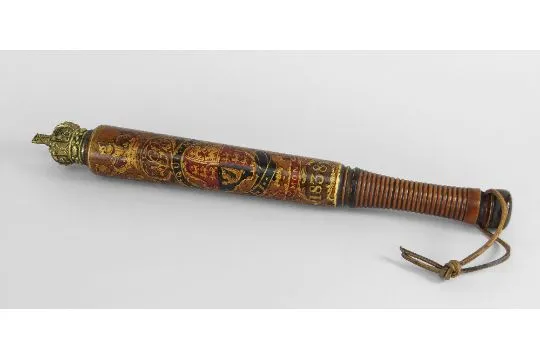I’m never surprised by the things people collect. Take the late Alistair McAlpine – one of the greatest collectors in living memory. His varied collections included: paper money from the Soviet Union, rare tribal flags, old roses, Venini glass, antique Venetian beads, early Scottish weapons, second-hand Hawaiian shirts and rare cattle. And police truncheons – 900 of them: for there’s more to a truncheon than at first meets the eye.
What are tipstaves?
Until the mid-1990s, every British police officer carried a traditional wooden truncheon, as they had done since 1829 when Sir Robert Peel founded the London Metropolitan Police: generally recognised as the first modern police force and a model for other police forces around the world. By 1856, every borough and county had, by Act of Parliament, to form its own police force.
But before the creation of modern policing, law enforcement was the responsibility of watchmen (often old men armed with a staff) and parish constables under the jurisdiction of local magistrates. Tipstaves or tipstaffs – more literally a ‘tipped staff’ – were carried as a symbol of office. These were ceremonial sticks, fashioned from wood or metal; sometimes hollow and topped with a crown in silver or brass, which, when unscrewed, might reveal a rolled-up paper warrant confirming the bearer’s authority.
Aside from the ceremonial role, inspectors and detectives carried tipstaves as badges of office which, in the latter case, were inscribed ‘...police officer in plainclothes’. With the introduction of the warrant card, they fell into obscurity before their abolition in 1887.
You might also like collecting Napoleonic memorabilia
What are truncheons?
In the tradition of tipstaves, early truncheons were used as much for identification as defence, and the new Metropolitan Police Force continued to adorn their truncheons with authoritative coats of arms. Policemen – known as ‘Bobbies’ or ‘Peelers’ – wore blue tailcoats and tall hats of varnished leather and carried a pair of handcuffs and a wooden rattle.
Twenty-inch truncheons were kept in a long pocket in the tail of their coat, deliberately hidden to emphasise the civilian nature of the force. These were turned from lancewood or male bamboo and painted black with the royal coat of arms placed above the initials ‘MP’ in gold, set against a red background.

The separate City of London Police had a similar truncheon but painted with the arms of the City Corporation. Later in the Victorian period, truncheons were decorated more simply, with the royal coat of arms removed and replaced by a simple ‘VR’ and crown.
In 1887, the Metropolitan Police issued instructions requiring existing truncheons to be cut down to 15½in. Inspectors, detectives, and plain-clothed officers used a smaller truncheon, which came in at 11½in. Truncheons were used as a restraint rather than as an offensive weapon, with strict controls enforced by a police code – limiting their use ‘except in extreme cases, when all other attempts had failed’. Policemen were supposed to target the legs and arms of an assailant, with strikes to the head considered only as a ‘last resort’.
Truncheons come in all shapes, sizes and decorations, and the painted arms, crests, and cyphers vary from one local force to another. Perhaps it’s this diversity that appeals to the seasoned collector: for truncheons were not only used by local police forces, but by private individuals, organisations, and railway companies, and for ceremonial purposes too.
You might also like collecting vampire slaying kits
How much are antique truncheons and tipstaves worth?
In 2017, a Georgian parish constable’s tipstaff was discovered in the attic of a farmhouse in Staffordshire and sold at Hansons auctioneers. It featured a carved wooden crown and a shaft only 7in long, painted with the king’s cypher and the date ‘1804’. Although worn, it fetched £260 against an estimate of £200–£300. And, in 2019, a splendid brass and silver-plated tipstaff from the Thames River Police (an early 19th-century local force that predated the Metropolitan Police) fetched £1,300 at Wallis & Wallis.
I’m taken with a rather stylish – and rare – truncheon from the Great Western Railway’s own police force, which came up for sale in 2018 at GW Railwayana Auctions and sold for £1,150. Octagonal in shape, it’s painted a dark blue and decorated with the Great Western cypher, garter and crown. Another recent lot that caught my eye was a rather beautiful early-Victorian truncheon (dated 1838, with a brass crown finial, not unlike a tipstaff) which sold at Rogers Jones & Co for £3,000 against an estimate of £300–£500.

